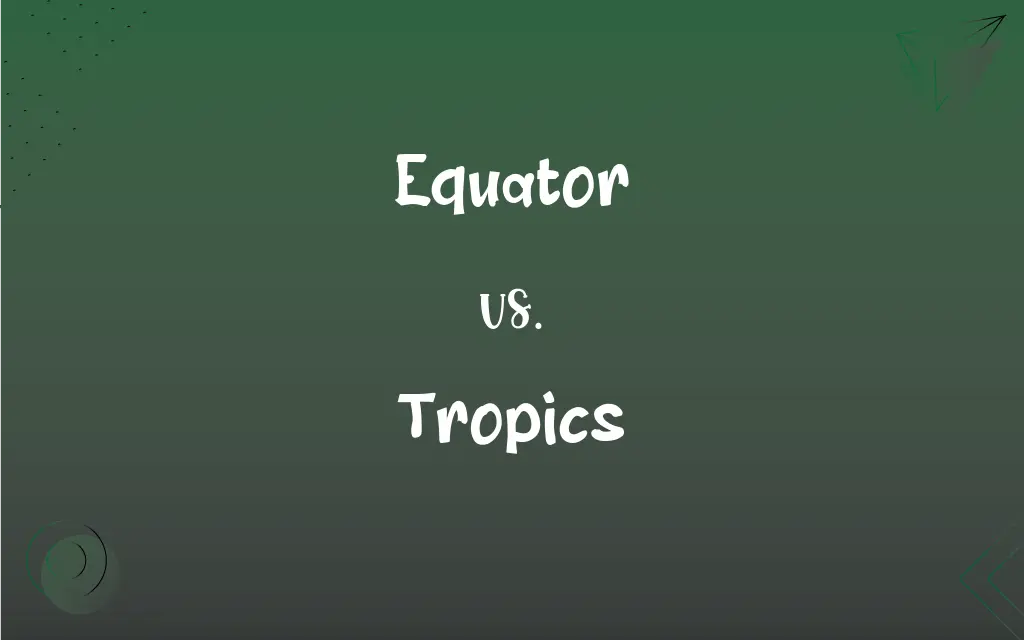Equator vs. Tropics: What's the Difference?
By Harlon Moss & Janet White || Updated on May 21, 2024
The Equator is an imaginary line around the middle of the Earth, dividing it into Northern and Southern Hemispheres, while the Tropics refer to the regions between the Tropic of Cancer and the Tropic of Capricorn, characterized by a warm climate.

Key Differences
The Equator is an imaginary line that encircles the Earth at 0 degrees latitude, marking the midpoint between the North and South Poles. This line divides the Earth into the Northern and Southern Hemispheres. The Tropics, on the other hand, are the regions of the Earth located between the Tropic of Cancer at approximately 23.5 degrees North and the Tropic of Capricorn at approximately 23.5 degrees South. These areas are characterized by their warm temperatures and seasonal rainfall patterns.
The Equator's climate is heavily influenced by its consistent solar exposure, resulting in minimal temperature variation throughout the year. In contrast, the Tropics, though also warm, can have more varied climatic conditions due to the influence of monsoons, trade winds, and other meteorological factors.
Geographically, the Equator crosses landmasses and bodies of water, including parts of South America, Africa, and Asia. Meanwhile, the Tropics encompass a larger area, covering parts of all continents and including diverse ecosystems like rainforests, savannas, and deserts.
In terms of cultural and ecological significance, the Equator hosts unique biodiversity hotspots such as the Amazon Rainforest. Conversely, the Tropics also support rich biodiversity and various human cultures adapted to tropical climates, such as those in Southeast Asia, Central America, and parts of Africa.
Comparison Chart
Definition
Imaginary line at 0 degrees latitude
Regions between the Tropic of Cancer and Capricorn
ADVERTISEMENT
Latitude Range
0 degrees
23.5 degrees North to 23.5 degrees South
Climate
Hot and humid, consistent
Warm, with wet and dry seasons
Solar Exposure
Direct sunlight year-round
High solar exposure, but varies seasonally
Geographic Coverage
Narrow line around the globe
Broad belt covering significant land and water
Equator and Tropics Definitions
Equator
A region known for its hot and humid climate.
Equatorial regions often have lush rainforests.
ADVERTISEMENT
Tropics
Encompasses diverse ecosystems.
Savannas, rainforests, and deserts are all found in the Tropics.
Equator
The imaginary line dividing Earth into Northern and Southern Hemispheres.
The Equator runs through several countries in South America and Africa.
Tropics
Regions between the Tropic of Cancer and Tropic of Capricorn.
The Tropics are known for their warm weather year-round.
Equator
Earth’s widest circumference.
The Equator is the longest latitude line on Earth.
Tropics
Zones with a variety of climates, often warm and wet.
Tropical rainforests are found within the Tropics.
Equator
Line of latitude at 0 degrees.
Quito is one of the major cities near the Equator.
Tropics
Area characterized by high biodiversity.
Many unique species thrive in the Tropics.
Equator
Point of equal distance from the North and South Poles.
Day and night are almost equal in duration at the Equator.
Tropics
Parts of Earth receiving direct sunlight at least once a year.
The sun is directly overhead in the Tropics during solstices.
Equator
The imaginary great circle around the earth's surface, equidistant from the poles and perpendicular to the earth's axis of rotation. It divides the earth into the Northern Hemisphere and the Southern Hemisphere.
Tropics
Plural of tropic
Equator
A similar great circle drawn on the surface of a celestial body at right angles to the axis of rotation.
Tropics
(geography) The region of the Earth centred on the equator and lying between the Tropic of Cancer and the Tropic of Capricorn and characterized by a hot climate.
Equator
The celestial equator.
Tropics
The part of the Earth's surface between the Tropic of Cancer and the Tropic of Capricorn; characterized by a hot climate
Equator
A circle that divides a sphere or other surface into congruent parts.
Equator
An imaginary great circle around Earth, equidistant from the two poles, and dividing earth's surface into the northern and southern hemisphere.
Equator
(astronomy) A similar great circle on any sphere, especially on a celestial body, or on other reasonably symmetrical three-dimensional body.
Equator
The midline of any generally spherical object, such as a fruit or vegetable, that has identifiable poles.
Slice the onion through the equator.
Equator
The celestial equator.
Equator
The imaginary great circle on the earth's surface, everywhere equally distant from the two poles, and dividing the earth's surface into two hemispheres.
Equator
The great circle of the celestial sphere, coincident with the plane of the earth's equator; - so called because when the sun is in it, the days and nights are of equal length; hence called also the equinoctial, and on maps, globes, etc., the equinoctial line.
Equator
An imaginary line around the Earth forming the great circle that is equidistant from the north and south poles;
The equator is the boundary between the northern and southern hemispheres
Equator
A circle dividing a sphere or other surface into two usually equal and symmetrical parts
FAQs
What defines the Tropics?
The Tropics are regions between the Tropic of Cancer and the Tropic of Capricorn, characterized by warm climates.
What latitude is the Equator at?
The Equator is at 0 degrees latitude.
Where are the Tropics located?
The Tropics are between 23.5 degrees North (Tropic of Cancer) and 23.5 degrees South (Tropic of Capricorn).
Do the Tropics have seasons?
Yes, the Tropics can have wet and dry seasons depending on their location.
How does the climate differ between the Equator and the Tropics?
The Equator has a consistently hot and humid climate, while the Tropics have warm temperatures with more seasonal variations.
What is a notable feature of equatorial regions?
Equatorial regions often have dense rainforests due to the high rainfall and humidity.
Why is the Equator important?
The Equator is important for its influence on climate, weather patterns, and biodiversity.
What is the Equator?
The Equator is an imaginary line around Earth at 0 degrees latitude, dividing it into Northern and Southern Hemispheres.
Can you find deserts in the Tropics?
Yes, some deserts, like the Sahara, are located within the Tropics.
How does solar exposure differ at the Equator and Tropics?
The Equator receives direct sunlight year-round, while the Tropics experience varying solar exposure throughout the year.
Which continents does the Equator cross?
The Equator crosses South America, Africa, and Asia.
What kind of biodiversity exists at the Equator?
The Equator hosts some of the world's most diverse ecosystems, including rainforests with vast species diversity.
What is the significance of the Tropic of Cancer and Tropic of Capricorn?
These lines mark the northernmost and southernmost points where the sun can be directly overhead.
How do the Tropics influence weather patterns?
The Tropics influence global weather patterns, including the formation of tropical storms and monsoons.
What is the temperature range at the Equator?
The Equator typically experiences temperatures between 77°F and 95°F (25°C to 35°C).
Do human cultures thrive in the Tropics?
Yes, many diverse cultures have adapted to living in tropical climates.
Why is the Equator known for having equal day and night durations?
The Equator's position ensures nearly equal hours of daylight and darkness throughout the year.
What ecosystems are found in the Tropics?
The Tropics host rainforests, savannas, deserts, and coral reefs.
What impact does the Equator have on global navigation?
The Equator serves as a key reference point for global navigation and mapping.
How do trade winds affect the Tropics?
Trade winds influence the weather patterns and climate of tropical regions.
About Author
Written by
Harlon MossHarlon is a seasoned quality moderator and accomplished content writer for Difference Wiki. An alumnus of the prestigious University of California, he earned his degree in Computer Science. Leveraging his academic background, Harlon brings a meticulous and informed perspective to his work, ensuring content accuracy and excellence.
Co-written by
Janet WhiteJanet White has been an esteemed writer and blogger for Difference Wiki. Holding a Master's degree in Science and Medical Journalism from the prestigious Boston University, she has consistently demonstrated her expertise and passion for her field. When she's not immersed in her work, Janet relishes her time exercising, delving into a good book, and cherishing moments with friends and family.































































